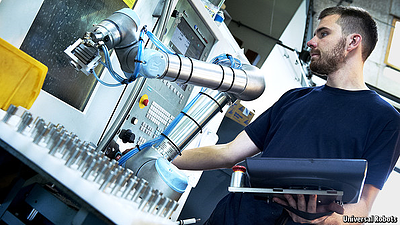Improving Workstations Ergonomically with Collaborative Robots
Posted on Jul 23, 2014 8:00 AM. 4 min read time
The importance of having good ergonomic work conditions for your human employees is essential for a smooth working environment. Though in reality many actual working environments may never have been reviewed in this light. Putting in place ergonomic work conditions will cost in the initial setup, studying your work processes and implementing the recommendations. But it will payoff with fewer injuries, particularly in repetitive stress situations, thus resulting in less absenteeism and fewer sick days. It often increases work flow, because of its ease of use, but also may eliminate the work stoppages that slow down production. One idea is to help employees work alongside collaborative robots, who preform the tasks that are likely to cause the most injuries, this is a great way to value your employees and increase production. 
In this blog, we will look at how to go about reviewing your work environment with regards to making your work space more ergonomic.
OSHA Report - Solutions
The Occupational Safety and Health Administration (OSHA) in the US produced a report on the “Solutions for the Prevention of Musculoskeletal Injuries in Foundries” publication 3465, which deals specifically with foundries. However the report states that “The solutions recommended in this publication may also be beneficial in other industries, such as those that handle heavy materials, use tools for multiple processes, and work on parts of widely varying sizes and shapes.” Actually I would posit that these manufacturing environments and many more that are found in most manufacturing processes could benefit from the use of collaborative robots to improve the ergonomics for the human employees and thereby improve workflow and ultimately production.
The report went to 6 foundries and distilled the results with examples of conditions and how they could be improved. While foundries are only one specific type of manufacturing. Most manufacturers could benefit by the guidelines used in analyzing the conditions found in these workplaces. We can use these same guidelines to tease out the ergonomic problems in your work environment too.
Guidelines
- provide management support – a strong commitment by management was deemed critical to the overall success of the implementation of an ergonomic process
- involve workers – these are the people who know the intricacies of the work process, they will ultimately know where the problems, bottlenecks, 'aches and pains' and stiff joints are coming from
-
provide training – in some instances a professional review may be beneficial, but starting with an internal review will help you in becoming more aware of work tasks that may lead to pain or injury, as well as the recognition of early symptoms of musculoskeletal disorders (MSD)
- identify problems – this will lead you to where it will be most cost productive to insert a collaborative robot, these potential ergonomic issues may have gone unnoticed or resulted from facility changes
- encourage and use reports of injuries - the goal of this effort is to properly assess and diagnose where the problems lie, this information can point out where to start and which processes will benefit the most from the addition of a collaborative robot
- implement solutions - here you will need to see your robot integrator, but the end results should reduces injury, the numbers of workers’ compensation claims and associated costs of continual hiring or absenteeism
- evaluate progress - enables an assessment of the effectiveness of the addition of your new collaborative robot, evaluation can be done by reviewing facility first-aid reports, absenteeism rates, job transfer requests, or other similar indicators, as well as by obtaining feedback from workers and supervisors to determine if the elimination of ergonomics-related issues has had the impact you were anticipating
According to the OSHA report many of the solutions “lowered injury rates and their associated workers’ compensation costs, and reduced employee turnover.” These are costs that effect your bottom line as much as the actual material costs related to manufacturing your widgets.
Helping employees to work alongside collaborative robots who preform the tasks that are likely to cause the most injuries is a great way to value your employees and increase production. This can only be a win – win situation.








Leave a comment